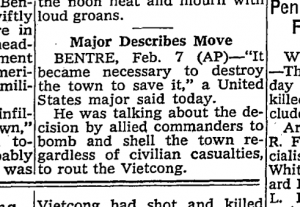The Sydney (Australia) Morning Herald from this morning [meaning October 15] has a piece on the crisis at Kobane, which is on the border that separates Syria and Turkey.
The article (“Have Obama and Abbott given up on Kobane?”–refering, of course the U.S. President and Aussie Prime Minister) is by Paul McGeough, based in Beirut. He says military planners and civilian overseers are “hog-tied by the constraints of conflicting coalition agendas” as they try and figure out just how much destruction is needed. McGeough says this brings to mind something said about 46 years ago:
This is a sometimes-doubted, oft-quoted, and more-oft-misquoted statement from an unidentified major as reported by Peter Arnett of the Associated Press on February 7, 1968. [The full article from the New York Times of February 8, 1968, appears at right.]…it all revives the wondrous claim by the American officer in Vietnam: “It became necssary to destroy the town to save it.”
The statement often appears as something like “We had to destroy the village in order to save it.” While some question the authenticity of the original reporting, the statement entered the lexicon in various forms. Glad that the original as-it-first-appeared-in-print comment remains in play here in Australia.
Would rather that someone would finally come clean about the original statement.
Was it actually said?
If so, who said it?
Then, let them trademark it. It has legs.

